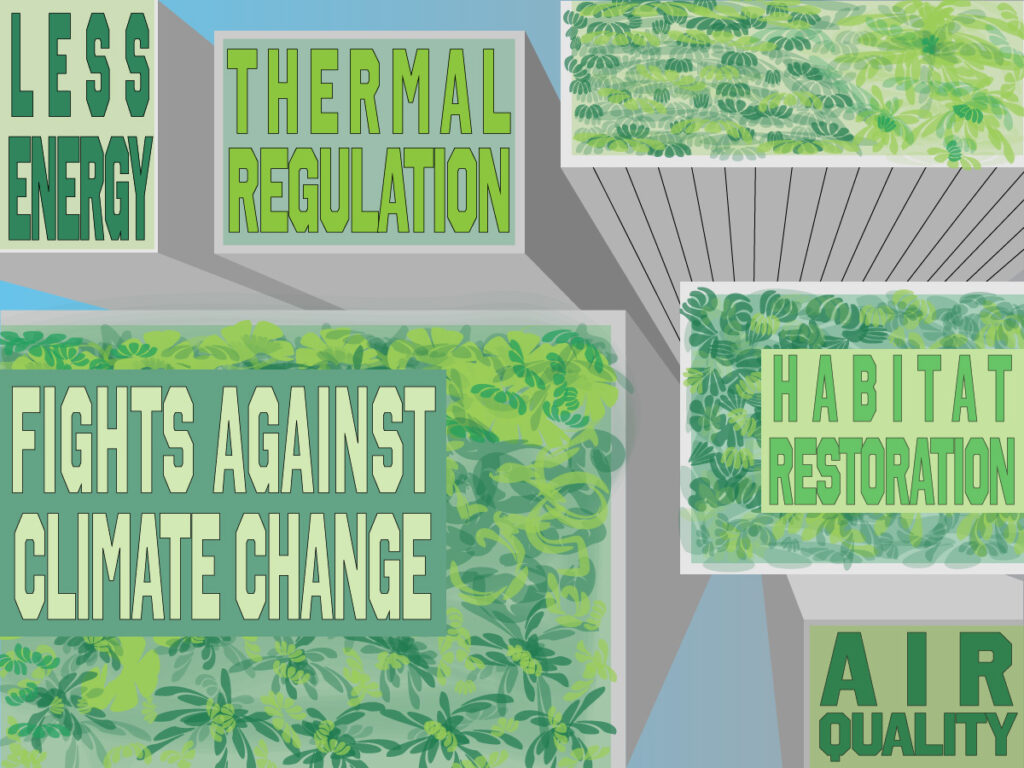What is a green roof?
A green roof is an add on to your existing roof. It is a garden that is built on your rooftop, with additional layers to protect your building. These layers often go in order of growing medium, drainage layer, root barrier, waterproofing membrane, and structural deck.
The growing medium would be what your plants are growing in, like soil. A drainage layer allows for excess water to be released. A root barrier prevents roots from growing into your building. The waterproofing membrane provides protection from water, and the structural deck ensures a sturdy base to build upon.Â
Economic Benefits of Green Roofs
Green roofs provide a number of economic advantages. First being that green roofs will extend the life of your roof, lasting twice as long as a normal roof. Â Rooftops are often hard-pressed by the elements- wind, rain, changes in temperature, UV light, you name it. Implementing a green roof will create a protective barrier between the weather and your roof. This is because a green roof is built on top of your existing roof. Another advantage of having a green roof is better temperature regulation. Typical rooftops often lack an adequate amount of insulation, which leads to considerable heat loss. A green roof will act as a great insulating layer.
Green roofs not only keep you warm in the winter but also keep you cool in the summer. The plants on your roof will absorb the sun’s light, meaning less heat will enter your building. A normal roof is supposed to be an impermeable layer that does not allow any water through. Combining all the roofs, roads, and parking lots leads to a lot of impermeable surfaces. All these impermeable surfaces prevent water from draining into the ground, leading to flooding. Green roofs will turn usually impermeable surfaces into a place where rainwater drains into, and keeps your plants happy. This aids in stormwater management and drainage.Â
Environmental Benefits of Green Roofs
Green roofs also come with a number of environmental benefits. Green roofs provide a habitat for local wildlife, specifically insects and birds. Your green roof should feature local native plants. This will ensure a normal habitat for your region that the native species will love. However, green roofs cannot completely replace ground environments. This shouldn’t deter you though as green roofs are still extremely beneficial to the local environment. Urban environments have the most to gain from green roofs. These types of places often lack green spaces leading to a number of problems, such as air quality and climate change.Â
Green roofs improve air quality by reducing levels of sulfur dioxide, nitric acid, and even dust particles. Plants also consume carbon dioxide, a main component of climate change. A green roof will absorb excess carbon dioxide, which aids us in our battle with climate change. Green roofs’ temperature regulation means less energy is used to heat or cool down the building. Pairing this with their ability to absorb CO2 provides a one-two punch against climate change.Â
Drawbacks of Green Roofs
The one major drawback to implementing a well-designed green roof is the cost to build it. However, this is mainly a one-time cost. A green roof will still require some maintenance to ensure it is working to its best capacity.Â
Green Roofs as Climate Change Mitigation
Hopefully, by now you agree that a green roof’s benefits far outweigh the drawbacks. As climate change worsens, we will be looking for any way possible to mitigate its effects. Implementing green infrastructure will contribute to ending the climate crisis.Â
Other interesting articles:



